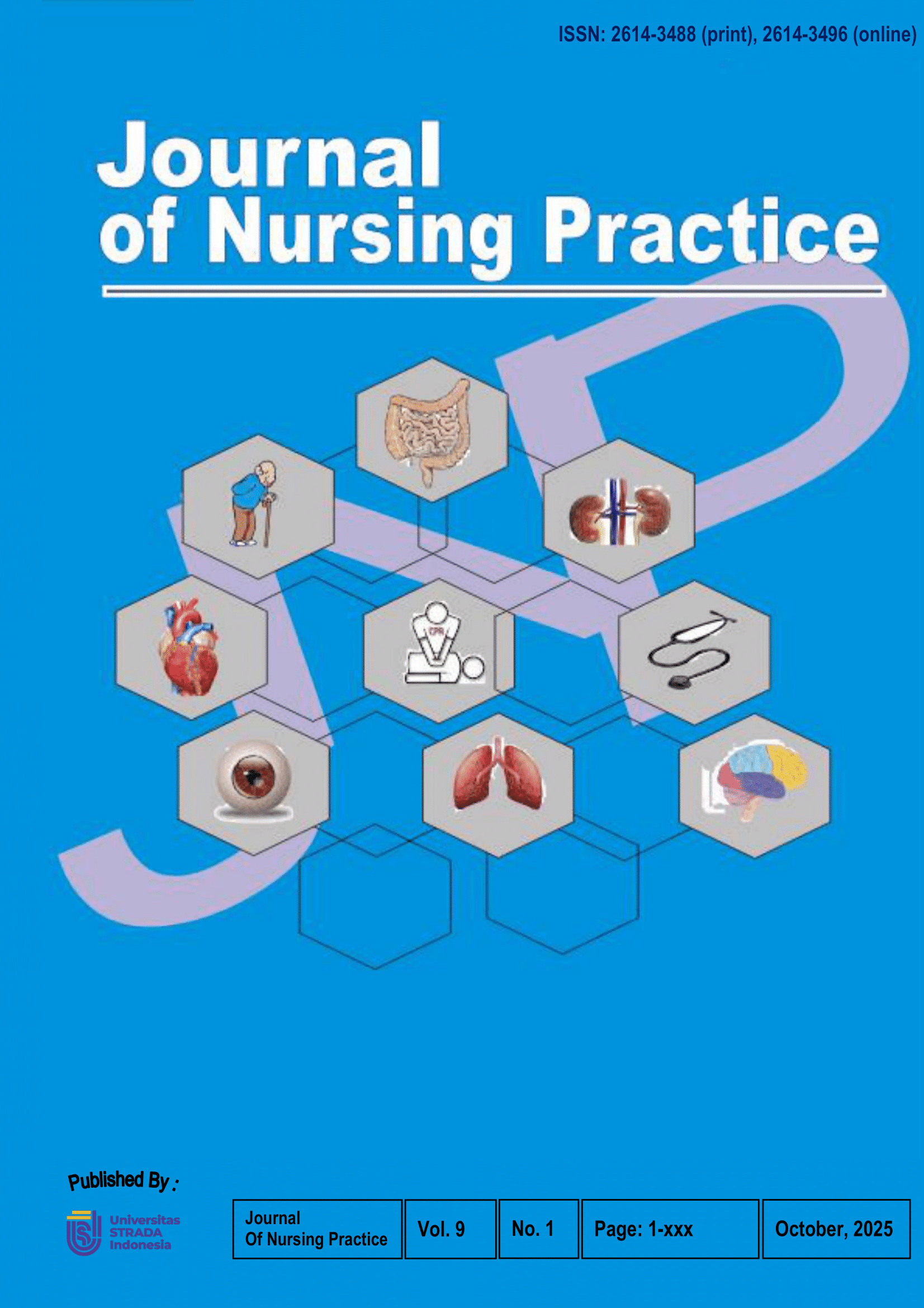Teenage Pregnancies in Indonesia: Does Socio-Economic Matter?
DOI:
https://doi.org/10.30994/jnp.v9i1.947Keywords:
physical, socio-economic, teenage pregnancyAbstract
Bacground: Teenage pregnancies is a crucial health problem in developing countries, including in Indonesia, which may cause various physical, psychological, emotional, and social problem including death for both mother and baby.
Purpose: This current research aimed to analyze the socio-economic relationship with the occurrence of teenage pregnancies in Indonesia.
Methods: This study uses secondary data for the 2017 IDHS with cross-sectional design. The dependent variable in this study is the prevalence of pregnant adolescents, while the independent variable is the socioeconomic status, the number of samples in this study was 3350 in women aged 20-24 years. The sampling technique uses simple random sampling. Analysis using binary logistic regression.
Results: The results showed that the poorer women had 0.804 times the probability of having teenage pregnancies (AOR 0.804; 95% CI 0.655-0.986). The women with middle socio-economic have 0.640 times more chance than the most impoverished women to have teenage pregnancies (AOR 0.640; 95% CI 0.514-0.797). The wealthier women have 0.804 times the probability of having teenage pregnancies compared to the poorest women (AOR 0.804; 95% CI 0.655-0.986). Moreover, the wealthiest women are 0.607 times more likely than the poorest women to have teenage pregnancies (AOR 0.607; 95% CI 0.447-0.823).
Conclusion: The study concluded that socio-economic proved to be related to the occurrence of teenage pregnancies in Indonesia. Also, there are 3 other variables which are also significant predictors of teenage pregnancy. The three variables are age, education level, and employment status.
Downloads
References
Ahorlu, C. K., Pfeiffer, C. and Obrist, B. (2015) ‘Socio-cultural and economic factors influencing adolescents’ resilience against the threat of teenage pregnancy: a cross-sectional survey in Accra, Ghana’, Reprod Health, 12. doi: 10.1186/s12978-015-0113-9.
Ampiah, M. K. M. et al. (2019) ‘Comparative analysis of trends and determinants of anaemia between adult and teenage pregnant women in two rural districts of Ghana’. BMC Public Health, pp. 1–9.
Chijere, G. et al. (2019) ‘An evolution of socioeconomic related inequality in teenage pregnancy and childbearing in Malawi’, 207, pp. 1–16.
D.A., W. et al. (2020) ‘Intergenerational patterns of early marriage and childbearing in Rural Central Java, Indonesia’, Journal of Population and Social Studies, 28(3), pp. 250–264. doi: 10.25133/JPSSV28N3.017.
Ellis-sloan, K. (2019) ‘Teenage mothers in later life : Time for a second look’, Journal of Adolescence. Elsevier, 77(October), pp. 98–107. doi: 10.1016/j.adolescence.2019.10.007.
Jewkes, R. et al. (2001) ‘Relationship dynamics and teenage pregnancy in South Africa’, Soc Sci Med, 52. doi: 10.1016/S0277-9536(00)00177-5.
Kassa, G. M. et al. (2018) ‘Prevalence and determinants of adolescent pregnancy in Africa: a systematic review and Meta-analysis’, Reproductive Health. Reproductive Health, 15(1), pp. 1–17. doi: 10.1186/s12978-018-0640-2.
Kassa, G. M., Arowojolu, A. O. and Odukogbe, A. A. (2019) ‘Trends and determinants of teenage childbearing in Ethiopia : evidence from the 2000 to 2016 demographic and health surveys’. Italian Journal of Pediatrics, pp. 1–13.
Kirchengast, S. (2016) ‘Teenage Pregnancies: A Worldwide Social and Medical Problem’, Intech, 32(July), pp. 137–144. doi: 10.5772/65462.
Kusrini, I. et al. (2021) ‘Demographic Characteristics of Mother as Predictor of Low Birth Weight in Eastern Indonesia’, Systematic Reviews in Pharmacy, 12(1), pp. 1514–1518. doi: 10.31838/srp.2021.1.213.
Laksono, A. D., Wulandari, R. D. and Rukmini, R. (2021) ‘The determinant of healthcare childbirth among young people in Indonesia’, Journal of Public Health Research, 10(1), pp. 28–34. doi: 10.4081/jphr.2021.1890.
Madut, K. K. (no date) ‘Determinants of Early Marriage and Construction of Gender Roles in South Sudan’, SAGE Open, 10(2). doi: 10.1177/2158244020922974.
McHunu, G. et al. (2012) ‘Adolescent pregnancy and associated factors in south African youth’, Afr Health Sci, 12.
Muharry, A., Hakimi, M. and Wahyuni, B. (2018) ‘Family Structure and Early Marriage on Women in Indramayu Regency’, Jurnal Kesehatan Masyarakat, 13(3), pp. 314–322. doi: 10.15294/kemas.v13i3.8946.
National Population and Family Planning Board, Statistics Indonesia, M. of H. (2017) ‘The DHS Program. Indonesia Demographic and Health Survey 2017’.
Nkosi, N. N. and Pretorius, E. (2019) ‘The Influence Of Teenage Pregnancy On Education: Perceptions Of Educators At A Secondary School In Tembisa, Gauteng’, Social Work, 55(9), pp. 108–116. doi: 10.15270/55-1-698.
Papri, F. S. et al. (2016) ‘Adolescent Pregnancy: Risk Factors, Outcome and Prevention’, Chattagram Maa-O-Shishu Hospital Medical College Journal, 15(1), pp. 53–56. doi: 10.3329/cmoshmcj.v15i1.28764.
Parsons, J. et al. (2015) ‘Economic impacts of child marriage: a review of the literature’, Review Faith Int Affairs, 13. doi: 10.1080/15570274.2015.1075757.
Paul, P. (2019) ‘Effects of education and poverty on the prevalence of girl child marriage in India: A district–level analysis’, Children and Youth Services Review, 100, pp. 16–21. doi: 10.1016/j.childyouth.2019.02.033.
Poudel, S. et al. (2018) ‘Trends and factors associated with pregnancies among adolescent women in Nepal : Pooled analysis of Nepal Demographic and Health Surveys ( 2006 , 2011 and 2016 )’, pp. 1–13.
Rachakonda, L., Rawate, S. and Shiradkar, S. (2014) ‘Teenage pregnancy’, 4(2), pp. 59–63.
Razu, S. R. (2018) ‘Determinants of early marriage among women: An experience from rural Bangladesh’, Gender Studies, 17(1), pp. 127–136. doi: 10.2478/genst-2019-0011.
Rohmah, N. et al. (2020) ‘Determinants of teenage pregnancy in Indonesia’, Indian Journal of Forensic Medicine and Toxicology, 14(3), pp. 2080–2085. doi: https://doi.org/10.37506/ijfmt.v14i3.10736.
Sarder, M. A., Alauddin, H. and Ahammed, B. (2020) ‘Determinants of Teenage Marital Pregnancy among Bangladeshi Women: An Analysis by the Cox Proportional Hazard Model’, Social Health and Behavior, 3(4), pp. 137–143. doi: 10.4103/SHB.SHB.
Supadmi, S. et al. (2020) ‘The Low Birth Weight in Indonesia: Does Antenatal Care Matter?’, International Journal of Innovation, Creativity and Change, 14(9), pp. 490–500.
Sychareun, V. et al. (2018) ‘Determinants of adolescent pregnancy and access to reproductive and sexual health services for married and unmarried adolescents in rural Lao PDR : a qualitative study’, BMC Pregnancy and Childbirth. BMC Pregnancy and Childbirth, 18(219), pp. 1–12.
Talukder, A. et al. (2020) ‘Early marriage in Bangladesh: A cross-sectional study exploring the associated factors’, Journal of International Women’s Studies, 21(1), pp. 68–78.
United Nations Population Division World Population Prospects. (2020) Adolescent fertility rate (births per 1,000 women ages 15-19) - Indonesia, The World Bank.
WHO, D. of R. health and R. (2017) ‘Adolescent pregnancy fact sheet’.
Wulandari, R. D. et al. (2019) ‘Socioeconomic Disparities in Hospital Utilization among Elderly People in Indonesia’, Indian Journal of Public Health Research and Development. Surabaya, 10(11), pp. 1800–1804. doi: 10.5958/0976-5506.2019.03885.3.
Wulandari, R. D. and Laksono, A. D. (2020) ‘The association of socioeconomic status on early marriage among women in Rural Indonesia (Hubungan status ekonomi terhadap pernikahan dini pada perempuan di perdesaan indonesia)’, Jurnal Kesehatan Reproduksi, 11(2), pp. 115–124. doi: 10.22435/kespro.v11i2.3870.115-124.
Yidana, A. et al. (2015) ‘Socio-cultural determinants of contraceptives use among adolescents in northern Ghana’, Public Health Res, 5.
Downloads
Published
How to Cite
Issue
Section
License
Copyright (c) 2025 Journal Of Nursing Practice

This work is licensed under a Creative Commons Attribution-NonCommercial-ShareAlike 4.0 International License.

This work is licensed under a Creative Commons Attribution-NonCommercial-ShareAlike 4.0 International License.






















